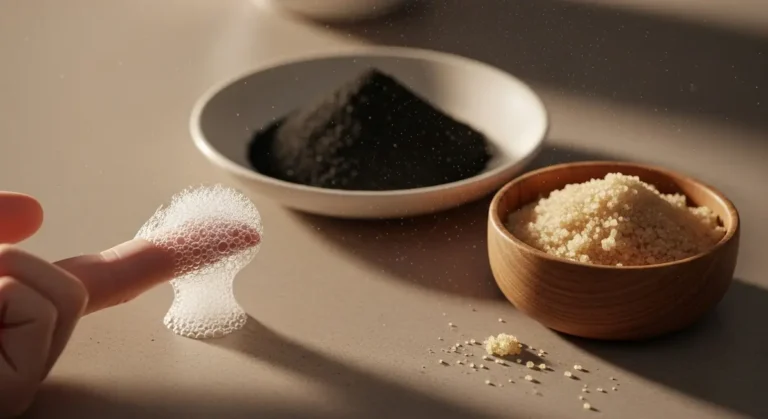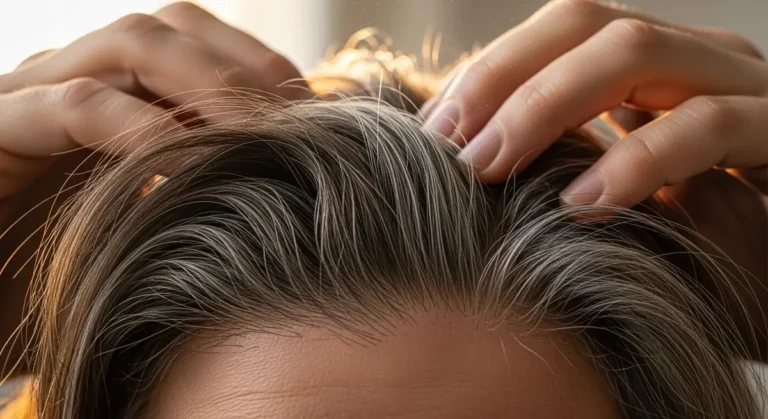If you’re noticing early hair thinning, you’re not alone — and choosing gentle, evidence-informed natural hair loss remedies can be a smart, sustainable first step. This guide explains practical, low-risk methods you can try at home: how to use scalp massage and essential oils safely, dietary and supplement strategies, and daily habits that protect hair health. Keep in mind results vary per individual; be patient and consistent, and consult a clinician for sudden or heavy shedding.
Scalp Massage and Essential Oils: Natural Hair Loss Remedies That Work

Early thinning is frustrating and often feels personal, but simple, consistent attention to the scalp can make a meaningful difference to scalp comfort and hair quality for many people. Regular scalp massage improves local circulation, eases scalp tension, and may help create a healthier environment for hair follicles. When combined carefully with well-chosen essential oils — especially rosemary oil, which has clinical trial support — these low-risk practices become practical options to try at home alongside medical advice.
How scalp massage helps
Scalp massage encourages blood flow to the skin, can reduce muscular tension around the head and neck, and helps distribute natural oils. Mechanically stimulating the scalp may also encourage follicles to remain in a healthier growth cycle; small studies and pilot trials suggest measurable increases in hair thickness after months of consistent massage, though individual responses vary. Think of massage as supportive care that complements good nutrition, stress management, and medical treatment when needed.
Basic daily scalp-massage technique (gentle, effective)
- Sit comfortably with good posture and relaxed shoulders; use your fingertips (not nails).
- Start at the hairline and work toward the crown in small, circular motions with light-to-medium pressure: enough to feel the tissue move under your fingertips but not painful. Aim for 5–10 minutes total.
- Use alternating fingertips (both hands) to create a steady rhythm: 30–60 second focus on each major area (forehead/hairline, temples, crown, sides, nape).
- Add a gentle kneading or lifting motion: press fingers into the scalp and lift slightly, releasing to relieve tension.
- Finish by smoothing the hair from roots to ends with the palms to distribute sebum and any applied oil.
Timing and frequency
- Ideal: about 5–10 minutes daily. If daily isn’t realistic, try at least 3–4 times per week.
- For a deeper treatment, 15–20 minutes once weekly with a warmed oil pack can feel restorative.
- Expect gradual changes; measurable improvements in thickness or density, if they occur, often appear after 3–6 months of consistent practice. Results vary per individual.
Essential oils — what the evidence says
Rosemary essential oil has been studied specifically for androgenetic hair thinning. A randomized trial comparing rosemary oil against 2% minoxidil reported similar improvement in hair growth over 6 months with fewer complaints of scalp itching in the rosemary group, suggesting a possible role for rosemary as a topical option for some people. Other small studies and laboratory research support rosemary’s anti-inflammatory and circulation-promoting effects, but evidence remains limited compared with established medical treatments.
Important: scientific support is promising but not definitive, and essential oils are complementary options rather than guaranteed cures. Consult a clinician for sudden or heavy hair loss.
Safe dilution and carrier oils
Essential oils are highly concentrated and must be diluted before scalp use. Common, safe dilution guidelines for adult scalp use:
- 1% dilution (low): ~6 drops of essential oil per 30 mL (1 ounce) carrier oil — suitable for very sensitive skin or initial testing.
- 2% dilution (standard): ~12 drops per 30 mL carrier oil — balanced for regular scalp application.
- 3–5% (treatment): 18–30 drops per 30 mL — for short-term, targeted use; use cautiously and not on broken skin.
Good carrier oil choices: jojoba (closely mimics sebum), fractionated coconut oil (light, non-greasy), sweet almond oil (nourishing), or grapeseed oil (lightweight). Warm the bottle briefly in warm water before applying for added comfort — never heat essential oils directly.
Patch test guidance
Always patch-test any new diluted blend:
- Apply a small drop of the diluted oil to the inner forearm and cover with a plaster or bandage.
- Wait 24–48 hours; check for redness, itching, swelling, or blistering.
- If any irritation occurs, discontinue use and wash the area with mild soap.
Practical, evidence-informed recipes
Note: the following are examples based on a 2% dilution in 30 mL carrier oil (about 12 drops total essential oil). Adjust proportions for larger or smaller volumes.
- Everyday stimulation blend (2%): 30 mL jojoba + 8 drops rosemary + 4 drops lavandin or lavender (calming).
- Deep weekly treatment (2%): 30 mL fractionated coconut oil warmed + 7 drops rosemary + 3 drops cedarwood + 2 drops peppermint (peppermint is stimulating; use less if sensitive).
- Gentle calming blend (1% for sensitive skin): 30 mL almond oil + 6 drops lavender (a low-dose option to avoid irritation).
How to use the blends
- For daily use: place a few drops on fingertips and massage into the scalp for 5–10 minutes; no need to rinse unless you prefer.
- For a deep treatment: warm the oil slightly, massage for 10–15 minutes, leave for 30–60 minutes (or overnight under a towel), then shampoo as usual.
- Avoid applying undiluted essential oil to the scalp.
Practical cautions and interactions
- Allergies and sensitivity: always patch-test. Stop use if itching, burning, or a rash appears.
- Scalp conditions: if you have active psoriasis, eczema, open sores, or severe dandruff, consult a dermatologist before using oils — some conditions can be aggravated by oils or massage.
- Pregnancy, breastfeeding, children, epilepsy: several essential oils (including rosemary, peppermint, and others) can be contraindicated or require medical supervision; check with a healthcare provider prior to use.
- Combining with medical treatments: topical medications like minoxidil are typically safe to use with diluted essential oils, but they can cause combined irritation. Consider applying oils at a different time of day than medicated topicals, or talk with your clinician about a schedule that reduces irritation risk.
- Ingestion: do not ingest essential oils unless under the supervision of a qualified professional.
Tracking progress and realistic expectations
Keep a simple log (date, duration of massage, oil used, any reactions, photos every 4–8 weeks). Small improvements in scalp comfort, reduced breakage, or thicker-looking hair can be meaningful outcomes. Full regrowth is not guaranteed; natural hair loss remedies are best viewed as supportive strategies that may slow thinning and improve hair quality over time.
Final note and disclaimer
Gentle, consistent scalp massage and thoughtfully diluted essential oils like rosemary can be useful, low-risk additions to a broader hair health plan. Results vary per individual; if you notice rapid or heavy shedding, seek evaluation to exclude treatable medical causes before relying solely on topical measures.
Disclaimer: results vary per individual. Consult a clinician for sudden or severe hair loss or before using essential oils during pregnancy or with medical conditions.
Nutrition and Supplements to Support Hair Growth

Strong, resilient hair depends on more than good shampoos and gentle styling—what you eat and the supplements you choose can provide the building blocks follicles need to make healthy strands. For adults noticing early thinning, a food-first approach combined with thoughtful, evidence-informed supplementation often offers the best balance between safety and potential benefit. Results differ between people, and meaningful change takes time; still, supporting core nutritional needs is one of the lowest-risk, highest-reward steps you can take.
Key nutrients that support hair strength
-
Protein. Hair is made largely of keratin, a protein, so adequate protein intake is essential. Aim for a daily baseline of about 0.8 g per kg body weight, and consider 1.0–1.2 g/kg if you’re actively trying to improve hair quality or have higher overall protein needs. Good sources: lean meats, poultry, eggs, dairy, legumes, tofu, tempeh, and quinoa.
-
Iron. Iron deficiency is a common, reversible contributor to hair shedding, especially in people who menstruate, follow restrictive diets, or have GI malabsorption. Dietary sources include red meat, poultry, legumes, spinach, and iron-fortified cereals—eat with vitamin C (citrus, peppers) to boost absorption. Typical recommended daily amounts are 8 mg for adult men and 18 mg for menstruating women; supplementation should follow testing and clinician guidance.
-
Vitamin D. Low vitamin D levels have been associated with hair thinning in some studies. The general RDA for many adults is 600–800 IU/day, but many clinicians test 25(OH)D and supplement to reach a target considered sufficient (often >30 ng/mL). Fatty fish, fortified dairy or plant milks, and sensible sun exposure contribute dietary and behavioral support.
-
Zinc. Important for hair cycle regulation and repair, zinc deficiencies can present with hair loss and slow wound healing. RDAs are about 8 mg/day for women and 11 mg/day for men; chronic zinc doses above 40 mg/day risk inducing copper deficiency.
-
Omega-3 fatty acids. Anti-inflammatory omega-3s support scalp health and may improve hair shine and density. Aim for food sources first—fatty fish like salmon, mackerel, sardines twice weekly, plus plant sources such as flaxseed or walnuts. If supplementing, many experts recommend 250–500 mg combined EPA+DHA daily for general health support.
Food-first strategies build a reliable foundation for hair health; if diet is limited (vegetarian, vegan, or restricted by allergies), targeted supplements can fill likely gaps. For practical meal ideas and daily swaps that bolster these nutrients, a balanced, hair-strengthening eating plan can be helpful: balanced, hair-strengthening eating plan.
Evidence-backed supplements to consider
-
Saw palmetto. Some small studies suggest saw palmetto extract (often 320 mg/day of a standardized extract) can reduce DHT activity at the scalp and modestly improve hair counts in androgen-related thinning. Evidence is mixed and effects are generally subtler than prescription therapies.
-
Pumpkin seed oil. Trials using around 400 mg/day have reported improvements in hair growth measures for some people; proposed mechanisms include mild anti-androgen effects and improved scalp conditions. More research is needed, but it’s a low-risk option for many.
-
Marine omega-3s and zinc combinations. Some studies show combination supplements can reduce hair shedding and improve hair density; benefits are usually gradual and modest.
-
Biotin. True biotin deficiency is rare. High-dose biotin supplements are often promoted for hair, but routine supplementation without deficiency rarely helps and can interfere with certain lab tests (notably some cardiac troponin assays). Use only if deficiency is suspected or proven.
Suggested daily targets (food-first, then supplement if needed)
- Protein: at least 0.8 g/kg body weight; consider 1.0–1.2 g/kg when supporting hair growth.
- Iron: follow age/sex-based RDAs (8 mg men; 18 mg menstruating women); supplement only if tests indicate deficiency.
- Vitamin D: 600–800 IU/day common RDA; supplement based on blood 25(OH)D levels.
- Zinc: ~8–11 mg/day from diet; avoid chronic supplemental doses >40 mg/day without supervision.
- Omega-3 (EPA+DHA): 250–500 mg/day from food or supplements.
- Saw palmetto: commonly studied at ~320 mg/day; consult a clinician first.
- Pumpkin seed oil: trials often used ~400 mg/day.
Signs of possible deficiency and when to test
Noticeable, persistent shedding, hair that becomes dry, brittle, or slow to grow, alongside systemic symptoms like fatigue, pallor, or recurrent infections, may point to a nutrient gap. Recommended initial tests for unexplained or persistent thinning include a CBC (to check for anemia), ferritin (iron stores), thyroid-stimulating hormone (TSH), and 25(OH) vitamin D; zinc and other micronutrient testing may be warranted based on diet and clinical history. Test especially if you have heavy periods, restrictive eating, recent bariatric or GI surgery, or symptoms beyond hair changes.
Safety, interactions, and realistic expectations
Supplements can help but are not magic. Expect at least 3–6 months of consistent diet and supplementation before judging effect on hair density; hair grows slowly and follicles cycle over months. Some specific safety notes:
- Iron supplements can cause GI upset and should be taken under medical advice—excess iron is harmful.
- High-dose omega-3s can increase bleeding risk when combined with anticoagulant medications.
- Saw palmetto has mild hormonal effects; avoid or consult a clinician if pregnant, breastfeeding, or on hormonal therapies.
- Zinc excess may cause copper deficiency; long-term doses above the tolerable upper intake (40 mg/day) need monitoring.
- Biotin can interfere with lab assays; disclose biotin use to any clinician ordering blood tests.
Because supplements can interact with medications and underlying health conditions, check with a primary care provider or dermatologist before starting new regimens—especially if you take blood thinners, hormone treatments, or have chronic medical conditions.
Most importantly: prioritize nutrient-rich eating, focus on realistic, patient-centered expectations, and use supplements selectively and safely. Results vary per individual, and a careful, food-first plan plus targeted testing and professional guidance when needed offers the best path forward.
Sustainable Daily Habits and a Gentle Hair Care Routine

Early hair thinning is often gradual, and the most reliable approach is steady, low-risk care that supports scalp health and reduces ongoing damage. Small, sustainable habits add up: managing stress in realistic ways, protecting hair from mechanical and chemical wear, supporting sleep and movement, and choosing milder products can all make a difference without chasing quick fixes.
Start by addressing stress with practical tools that fit your life. Chronic stress affects hormones and can accelerate shedding for some people, so aim for simple, repeatable routines rather than grand promises. Brief daily practices—five minutes of deep, diaphragmatic breathing, a short guided mindfulness exercise, or a calm evening walk—help lower tension over time. When stress is overwhelming or persistent, professional support (a therapist, counselor, or coach) and social connection are equally important; managing the root causes of stress is more effective than constant symptom-checking.
Prioritize sleep and movement because they support whole-body repair. Aim for consistent sleep times and roughly 7–9 hours per night; sleep influences hormone balance, inflammation levels, and tissue repair, all relevant to hair health. Regular physical activity—especially a mix of moderate cardio and strength training—improves circulation and metabolic health, which indirectly supports the scalp and follicles. Even brisk 30-minute walks most days of the week and two short strength sessions can be beneficial and are easy long-term habits.
A gentle hair-care routine reduces breakage and visible thinning. Avoid tight hairstyles like high ponytails, tight braids, and rigid buns that tug on hair roots; instead, use loose, low styles and soft hair ties (fabric scrunchies or seamless bands). When towel-drying, blot or squeeze hair gently rather than rubbing; detangle with a wide-tooth comb starting at the ends and working upward.
Shampoo and product choices matter less than how you use them, but selecting mild, well-formulated products helps if your scalp is sensitive or your hair is fragile. Prefer sulfate-free or low-sulfate cleansers if you notice dryness or irritation; wash frequency should match your scalp type—less frequent washing for dry scalps, more frequent for oily scalps—but avoid daily harsh scrubbing. Conditioners and leave-in treatments should focus on moisturizing the mid-lengths and ends; apply richer products away from the scalp if you’re prone to buildup.
Limit heat and chemical exposure. Heat tools and chemical services can weaken hair structure over time. Keep blow-drying to lower or medium heat and use a heat protectant spray; consider air-drying when possible. If you use hot tools, aim to reduce temperature and frequency—think of heat styling as occasional rather than everyday. Space chemical treatments such as bleaching, perming, or relaxing several months apart and consult a stylist who uses bonding or repair-supportive products if you choose to color hair.
Build a realistic tracking plan that informs rather than obsesses. A gentle regimen benefits from periodic check-ins: standardized photos taken every 8–12 weeks under similar lighting and angle, a simple monthly note about shedding patterns or scalp symptoms, and a record of any new treatments or major life changes (medication, pregnancy, stress events). Avoid daily hair-counting and constant mirror-checking; normal shedding is common (many people lose up to ~50–100 hairs daily), and short-term fluctuations aren’t always meaningful. If you notice sudden, heavy shedding, visible bald patches, scalp pain, intense itch, or rapid change over a few weeks, seek medical evaluation sooner.
When to consult a clinician: persistent or rapidly worsening thinning, patchy hair loss, scalp inflammation, or symptoms like fatigue and irregular periods should prompt discussion with a primary care clinician or dermatologist. Blood tests for iron status, thyroid function, and vitamin D are commonly checked when there’s diffuse thinning, but testing decisions should be individualized. A clinician can also alert you to medical causes (autoimmune conditions, hormonal imbalances, medication effects) and guide evidence-based treatments beyond lifestyle steps.
Emphasize slow, cumulative change: natural hair loss remedies and daily habits benefit most when they’re simple enough to keep doing. Avoid aggressive or unproven ‘miracle’ interventions that promise fast regrowth; these often carry risk or false hope. Instead, combine gentle styling practices, consistent sleep and movement, stress-reduction strategies, and cautious product choices for a low-risk, supportive approach to early thinning.
Results vary per individual; if you experience sudden or heavy hair loss, seek professional evaluation to rule out treatable medical causes.
Conclusion
Natural hair loss remedies—like a consistent scalp massage routine, carefully chosen essential oils, nutrient-rich eating, and gentler daily habits—can slow early thinning and improve hair quality for many people. These approaches are safest when used patiently and alongside medical advice when needed. Remember that individual responses vary; if you see rapid or heavy hair loss, get evaluated to rule out treatable medical causes.
Try these natural tips today and note small changes over 3–6 months. For step-by-step routines and more gentle hair-care guides, visit RelexaHub’s hair care center.



